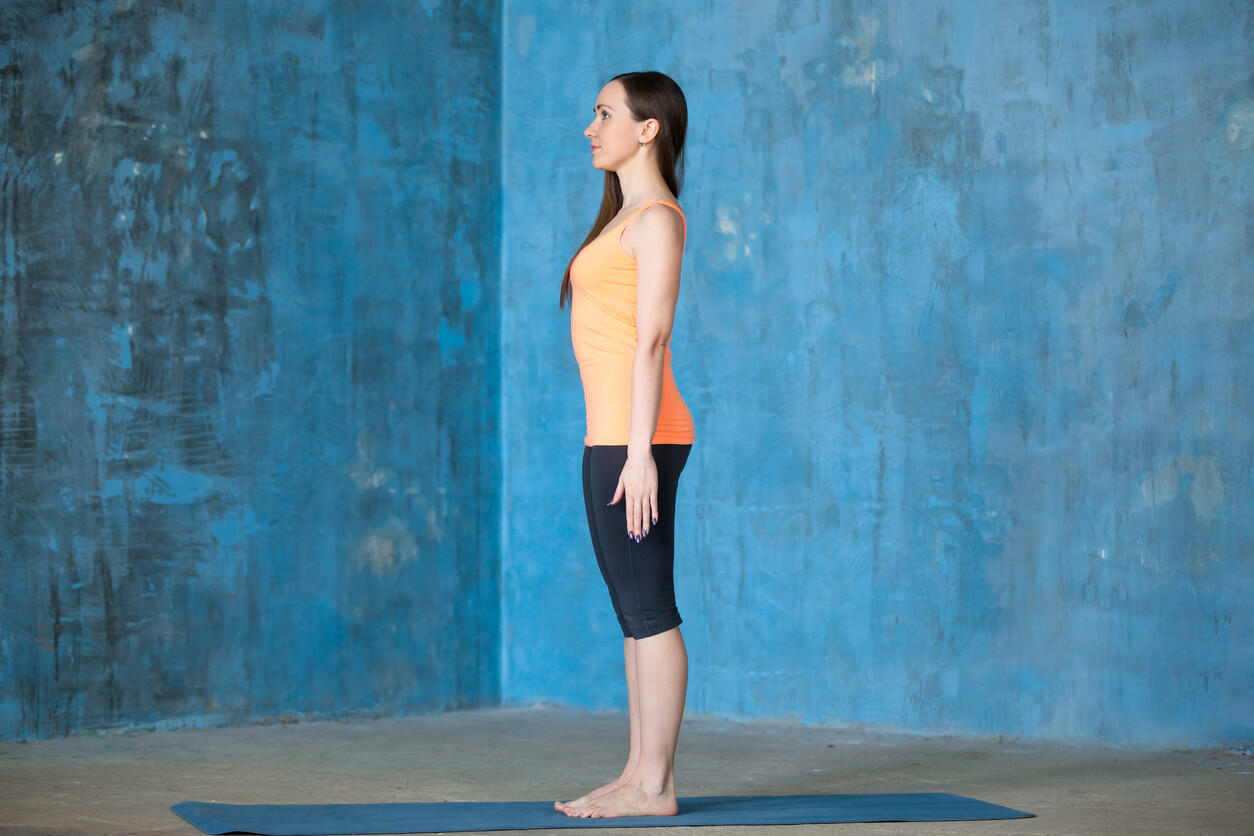Meet Vivian Eisenstadt, MAPT CPT MASP of Vivie Therapy in Beverlywood
The Ultimate Guide to Improving Your Posture
When I think about proper posture, the corners of my mouth curl up with an ironic smile. I have distinct memories of how my grandmother was hell-bent on having me and my sister stand with good posture. She would lecture us all the time to, “STAND STRAIGHT! Walk as if you are balancing a book on your head.” She would even hand me books to practice with. Imagine me walking down the street in Brooklyn with a book on my head trying to balance it. I remember the flat part of my head was at an angle where my head would have to tilt a bit to keep it on my head, so I didn’t really get the exercise because my neck would spasm sometimes, but I would practice because it was a challenge and as a tomboy, I loved a good game that was physical. Who knew that almost 4 decades later, most of my day would revolve around teaching other people how to stand straight and have proper posture? It still blows my mind how I ended up taking her pet peeve to the next level.
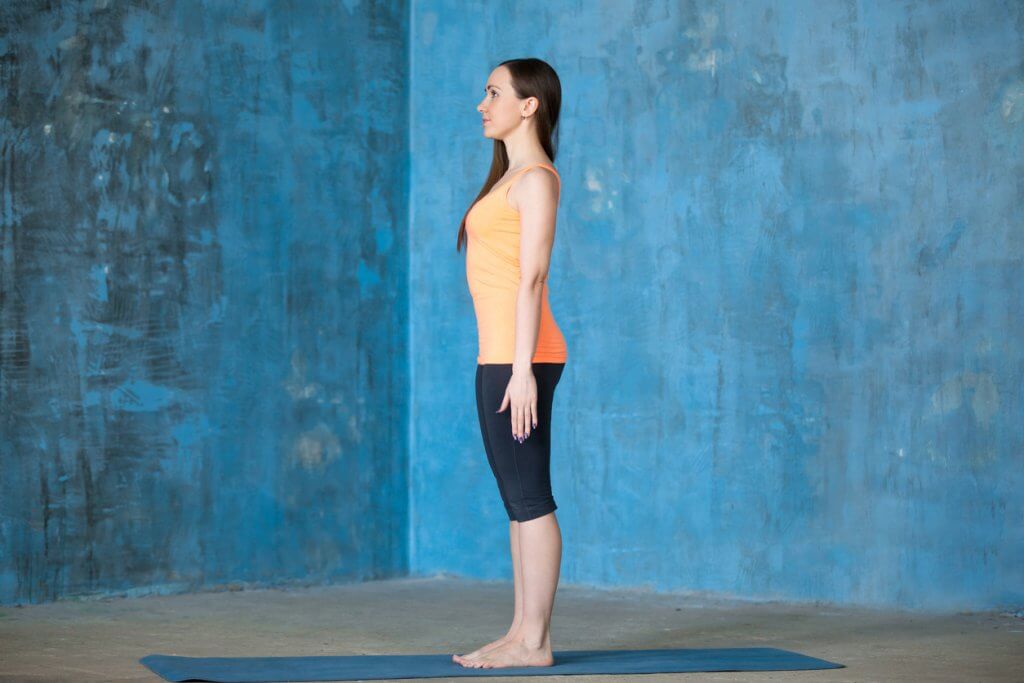
Posture affects health and well-being in every way possible:
Physically – In this age of computers, cars, planes, couches with televisions etc. we have developed what I call a “postural epidemic”. Over the past 10 years, my patient load has shifted from athletes and acute injuries to chronic neck and back pain, shoulder pain, headaches, forearm pain, hip pain, and all sorts of pain from hours upon end slumped over computers and poor posture in general.
- Chronic Pain – Poor posture leads to chronic physical pain. “Forward head,” which is the coined term for your head jutted forward over your body, closes the space between your vertebrae where the nerves leading to your head and arms come out, leading to neck pain, numbness, tingling and eventual weakness. I have patients that come in that can’t hold a cup because their neck is so far in front of their shoulders that the nerve to their fingers is being pinched. Rolled shoulders create similar symptoms because the nerves that go to your arms go through your shoulder area to get there and if you close the space there, the nerves get pinched there too. – Poor posture leads to chronic physical pain. “Forward head,” which is the coined term for your head jutted forward over your body, closes the space between your vertebrae where the nerves leading to your head and arms come out, leading to neck pain, numbness, tingling and eventual weakness. I have patients that come in that can’t hold a cup because their neck is so far in front of their shoulders that the nerve to their fingers is being pinched. Rolled shoulders create similar symptoms because the nerves that go to your arms go through your shoulder area to get there and if you close the space there, the nerves get pinched there too.
- Migraines – Migraines are also created by forward head. If you don’t correct your posture, the bones in your neck eventually degenerate and the pain can become permanent, only temporarily relieved by epidurals and fixed by surgery – and once you open up the body, it’s never the same.
- Mid-Low Back Pain – Rounded shoulders also leads to mid and low back pain. When your shoulders are rounded, your head starts to lean forward towards the ground. Our eyes like to look at the horizon so when you can’t bring your shoulders back to look ahead of you, you end up hyperextending your mid and low back to lift your head back up. This leads to low back and leg tightness, pain and debilitation.
- Sciatica – Slouching in your chair reverses the normal angle of your lower back, pushing the discs into the nerves in your low back leading to pain down your legs, familiarly known as “sciatica” because you’re compressing the sciatic nerve. Another common occurrence of sitting like crap is a rotated pelvis on one side, which also gives low back symptoms. The problem with a rotated hip is that it doesn’t show up on x-rays and MRI’s, so your doctor will just see how the change affected your disc and will treat it as so. To truly fix that, a physical therapist needs to put your pelvis back into the proper alignment and stretch the muscles that are keeping it out. Compression on your low back can also lead to numbness, tingling, and pain in one or both lower extremities.
- Physical Fatigue and Lack of Concentration – Fatigue comes quicker with those that slouch because once your neck is too tight, blood flow to the brain is more difficult. Poor posture tightens the secondary breathing muscles such as the scalene and levator, making it more difficult to breathe. By losing the ability to breathe properly, oxygen can’t get into your body as efficiently. I haven’t done studies on how bad that can be for your body, but I doubt it’s good.
Our bodies were meant to move and be fluid so that our circulatory and lymph system can function optimally, our discs stay uncompressed, and our food metabolized. Good posture is a major component in minimizing the fact that we don’t move a lot and help us stay pain free, or “vivie” (a word I made up to mean “pain-free”) and to stay out of my office to begin with.
For other people, poor posture is an eyesore. Have you ever seen an actress in a beautiful dress with poor posture? Makes me throw up in my mouth a little bit, although I am personally more sensitive to that as it’s what I do for a living. What a waste of all the makeup and stylist time if you are going to stand like an ape. Bottom line – it’s ugly.

Mentally & Emotionally – The way you stand and sit reflects to the world who you are as a person and how you might come across when you are out of balance versus balanced. Poor posture carries an energy with it. It can be read as lack of self-confidence, shyness and closed communication. Depression, fatigue, and insecurity are just some of the feelings that are associated with shoulders forward and forward head posture. “Keep your chin up” and “hold your head high” were not made up for nothing. Standing straight exudes a sense of pride and confidence, and promotes happiness. By standing straight, you actually feel better. Try it right now. I’ll bet you feel sexier. “Strut your stuff” carries an energy with it. There is a higher self-esteem that good posture gives you. When my patients stand straight and I fix their posture, I see the smile spread across their mouths. They fall more in love with themselves in a healthy way.
The bottom line is, by correcting posture, we also inadvertently heal issues emotionally connected to imbalance. Results are an increase in confidence, higher self-esteem, looking more attractive, more open and communicative relationships, more physical and mental energy and focus, as well as just feeling happier throughout the day.

What are some of the main reasons people develop poor posture?
As mentioned above, we are sitting and staring at a screen without moving our bodies for hours at a time. Children are starting to stare at iPads and iPhones at 6 months of age. Their bodies are actually developing with feedback to have poor posture and its getting more and more challenging to fix at younger and younger ages.
If you sit or stand crappy for long enough the muscles actually change their length. Picture the analogy of a circus tent where you have the poles and the guide wires. If the guide wire on one side is too tight, the pole will lean in that direction. Even if you push the pole back, if you don’t loosen the tension on the guide wire, the pole will continue to lean. Specific repeated stretching is necessary to correct the imbalance.
Gravity never takes a vacation, so any angle that we are out of alignment while we stay in these imbalanced positions will continue to get more extreme over time. Our bodies readjust to the constant abnormal position and literally shorten or lengthen their fibers into a more permanent state. Starting from the pelvis, people think sitting is OK with a c curve pelvis (tucked under us). This slouching is really the opposite angle that it should be. As a result, everything up the spinal chain repositions itself based on that opposite curve base. From the top of the spinal chain, because we are holding our necks in this slightly downward angle for hours on end without stretching, our scalene muscles are getting overly developed to the point where I have 12 year olds coming to me with severe neck pain. Your levators, traps, and all the muscles around your neck get tight because they are trying to hold your head up as you stare at the screen. Your pectorals or chest muscles also get tight adding to rounded shoulders, and then you have to extend your neck more to get your eyes level, compressing the discs in your neck even more.
Other reasons for poor posture are the following:
- People who are tall and were tall at an age where it wasn’t cool to be tall have the tendency to slouch, thinking that the slouching will make them less noticeable (which you know didn’t work anyway). Leaning their heads way forward is also how they get closer to people to hear them in social situations.
- Women with big breasts have tried to hide them and/or the heaviness of the breasts by bringing their shoulders forward.
- Nobody ever taught them how to sit and stand straight. Nobody taught them the importance of maintaining good posture at a young age, and if they did tell them to sit or stand straight, they never explained exactly how.
- People with poor self-esteem, shyness, depression or post-trauma tend to have poor posture because they are literally “brought down” by their situation.
On the other hand, good posture both sitting and standing will keep your bones and muscles where they should be, minimizing the tightness of aging and keeping you healthy. With good posture you can focus longer on what you’re doing because your body isn’t suffering and you’re breathing better.
If you correct your postural habits early enough in life, you can avoid some of the following: Months in physical therapy, epidurals, migraines, and operations to manage degeneration and disc herniation. You go into the world with more confidence, energy and you just look better. Preventative medicine is the new way to stay out of the health care system that pretty much bleeds your bank account. Wouldn’t you rather take the money you earned all those years and spend it on a new house, vacation or spa days instead of drugs, surgeries and therapy?
If you want to get that job, that audition, that girl to go out with you – show good posture. It displays a sense of self-care that others subconsciously read off of you. You will get more respect from other people when you have good posture. So stand up straight, sit straight and feel better in all ways possible.
The Importance of Correct Posture
At every moment of the day, we are either moving towards a state of wellness and balance, or moving away from it. In this age of computers, cars and couches, we end up staying in specific positions for long periods of time. It’s bad enough that some of our muscles literally shorten into imbalanced positions as a result, but poor posture creates an environment for our muscles to greater that imbalance until a point where our spinal discs are being compressed, our nerves are being choked, our circulation gets compromised and our muscles either atrophy or get so tight they are like bars of steel – all of which result in PAIN. And I don’t just mean minor pain. I mean the pain that doesn’t let you go to work, sleep or socialize – and your life revolves around how much pain you are in that day. Not a pretty way to spend the day.
Choosing proper postural positions is a constant reminder to your body to maintain balance. When you sit properly, your vertebrae are sitting on each other in a way that your back muscles don’t have to be turned on when not necessary and your neck muscles don’t choke your arm nerves. This preserves your energy, alertness, and focus. Standing properly can also preserve your lower back and neck from pain and the above scenario. Your body has enough to do throughout the day. Poor posture adds to fatigue and burnout.
Standing and sitting properly also effects how you are perceived by the world. When you sit with your shoulders slumped forward and your head jutted down, your energy is “closed”. It’s a way of telling the world signs that you just don’t care or you are sloppy etc. It’s basically ugly to look at as well. Nobody looks at someone slumping in their chair as sexy, I can tell you that. Sitting and standing straight with your shoulders back and your head held high shows confidence, open, high energy, loving strong signals. It’s also like the chicken and the egg – are you slumping because you’re tired or are you tired because you’re slumping?
You can determine if your posture is poor by the following:
Do you sit with your knees out to the side?
Is your pelvis tilted to your face when you’re sitting?
Is your head in front of your body?
When you bring your shoulders back, does your back extend instead?
Does your standing posture resemble more of an ape then a person?
If you answered yes to any of the above, then read how to sit and stand straight right now:
Preventative medicine and habits are the best way to care for your body and stay out of the health care system.
Physically, I fix posture by massaging and stretching the muscles pulling the person out of position, mobilizing the spine into balance, strengthening the weak postural muscles and teaching proper ergonomics. Mentally and emotionally I show the client the difference between how it “feels” to be out of balance and how that blocks your productivity, self-esteem, and emotional freedom – and can take a beautiful girl and make her look uglier.
For that reason alone people stand straighter. 🙂
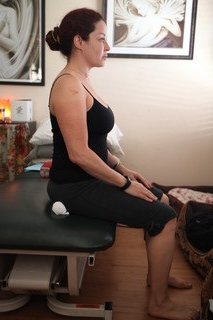
How to Sit Straight:
Sitting Straight – Sit with your feet shoulder length apart, with your heels even with the width of your hips. Keep your legs at 90 degrees at the knees and the hips – in other words UNCROSS YOUR LEGS! Crossing your legs makes your pelvis imbalanced. If your pelvis is imbalanced, it’s as if the base of your house is imbalanced. If your basement is off, your first, second and third floor will be off. In between your first and second toe should be even with your heels – even with the bone protrusion on the top of your shin (tibial tuberosity) – even with your hips (ischial tuberosities). Your pelvis should be angled so that the 2 bones on the bottom of your buttocks are closest to what you’re sitting on. You should have a small curve at the bottom of your back (not the middle). Slide your shoulders back without extending your mid-back and tuck your chin so that your head is on your body.
Another version I teach patients is with a rolled up hand towel:
Begin with a hand towel rolled up (if possible taped so it stays in tootsie roll shape). Sit on a stable surface (preferably a firm surface compared to a soft couch). Find the angle in which your “butt bones” (ischial tuberosities) are closest to the sitting surface. You can figure out how to feel the two bones at the lowest part of your tush and their angle by tilting your pelvis forward and backwards slightly while feeling more and less pressure on those bones. Make sure that you are sitting directly on top of them and not slightly in front or behind them. Once you find this optimal angle for your pelvis, lean forward slightly keeping your back straight and place the towel roll under the fat of your tush that is BEHIND the bones, not directly under the bones themselves. Sit back up and find that optimal angle again. Slightly contract your lower abdominals “like you have to go to the bathroom but don’t want to”. This will secure your lower “lumbar angle” and re-enforce pelvic stability. Once this is completed, make an effort to relax your upper body, especially shoulders and neck. Make sure that you are creating your lumbar arch from the lowest levels of your spine. The top of your low back “rainbow” is at the same level as your upper abdominal or “t-point” is, so make sure your upper abdominals are contracted slightly as well. Make sure your mid-back is not overly arched (creating a look like your upper body is in front of your lower body). Lastly pull your shoulders back and down using your mid back, not your neck and RELAX YOUR NECK.
Driving – The same goes for driving or any other sitting position. When you enter your car to drive, lean forward and shove your buttocks as far back as it will go, sticking your butt out a bit into the corner of the seat. Lean your body back onto the chair over your hips. Keep the back of your seat relatively vertical versus reclined. You might have to adjust your mirror a little higher to remind yourself to sit straight as well.
Lifting – When you are lifting objects, make a wide stance and bend from your knees and your hips versus leaning over from your low back. Most low backs are weak areas for people because they sit all day and are easily injured. Think of lifting with your legs as if you’re doing a squat exercise in the gym. Mindful movement is like doing mini workouts throughout your day. 🙂
Since we can’t avoid sitting throughout the day, the following are a few stretches and exercises that help maintain proper posture:
Neck stretch – Start in proper sitting posture with buttocks slightly arched and abdominals contracted. Put your right hand behind your back with the intention to lock the shoulder blade into position or hold on to the bottom of a chair seat. Keeping your chin tucked, reach your left hand over your head and grab by your right ear. Lean and pull your neck to the left. When you feel a muscle pulling, stop there and give your neck muscle time to “let go”. That might take a minute or 2 or 3…Once the muscle lets go, pull lightly to feel the next tight place. Try not to let your head start going forward to do a “better stretch”. The best stretch is one where you find your tightness and talk to it there. Once you have exhausted going straight ear to shoulder, only THEN can you start to rotate your head to look behind your right shoulder. Make sure to KEEP YOUR CHIN TUCKED throughout the range. You will probably start to feel stretching in the front of your neck versus the side. Do this for a couple of minutes. Then slowly get out of the stretch to starting position and switch sides.
Pec stretch in the doorway – Stand in a doorway with one foot through the doorway and your forearms on doorframe. Move your forearms to different levels on the doorway and slowly lean through the doorway feeling the stretch on the front of your shoulders. Return to standing by using your front leg to push you back as not to strain your stretched out pecs and shoulders. Change the angle of the stretch by moving your forearms up or down from your first position and repeat stretch. Find all the different angles that your shoulders are tight and lean into the tight angles.
Piriformis Stretch – Sit up straight and pull one leg up, resting your ankle on your opposite knee. Make sure your leg is parallel to the floor. Slowly bring your chest forward until you feel your hips begin to stretch. Make sure your back remains straight through the whole stretch. Stay in that position for 2-3 minutes then slowly raise your body back up. If you would like, perform the stretch again. Once you have finished one leg, move on to the other leg and repeat the same.
Tabletop – Lay on your back with shoulder blades “back and down”, sliding your hands towards your feet with your knees bent. Keep a small arch in your lower back, keeping your mid and upper back on the floor. Make sure your feet and knees are even with your hips (shoulder width apart). Make sure that your fingers are actively reaching for your heels in order to keep your neck shut off as to turn on your armpit muscles. Without moving anything in your upper body, slowly lift one leg 90/90 towards midline of your body – meaning your shin is even with the floor but in the air – look down if you have to. While only using your lower abs and hip flexors (NOT YOUR NECK, which you can work on by reaching those fingers) lift the second foot off the floor to 90/90 as well and squeeze your thighs together. Hold for as long as possible without using your lower back or neck. Usually hold until you feel burning and shaking in your abs and hip flexors plus 10 seconds. Slowly lower one leg at a time back to the floor. Repeat 5 sets of “holding as long as possible without having to use your neck or back.”
Know your game so you know how to play – In other words if you know your job entails being seated for 10 hours a day, make sure to get into good habits of stretching, exercising and drinking enough water to balance out the tightness you get from being in one position for so long. Once your body acclimates to being in the right position, it will also become the most comfortable one for you.
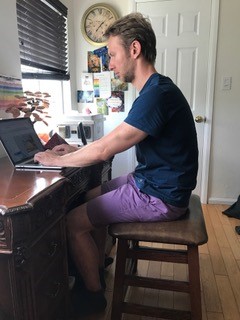
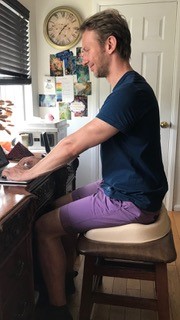
If you need help sitting correctly, you can purchase a bottoms-up posture seat for your office or car: https://www.vivietherapy.com/product/posture-seat-universal/
If you need help remembering to keep your shoulders back, you can purchase a clavicle brace: https://www.vivietherapy.com/product/clavicle-brace/
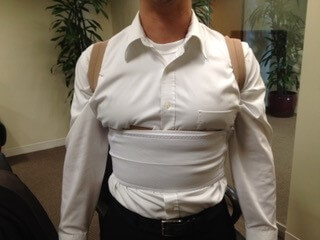
If you want extra support for your mid-back, buy a rib belt (It’s our best seller at Vivie Therapy): https://www.vivietherapy.com/product/rib-belt/
I also suggest going to a physical therapist and getting aligned so you know what balance feels like. Your therapist can also evaluate your posture and give you recommendations, postural education and teach you proper form with your exercises so you can feel confident in preventing your pain and staying vivie (pain free).
Hold your abs in with everything you do – Your center of force comes from in front of your second sacral vertebrae which is the level of your low abs near your pelvis. By holding in your abs before you move, your body will want to choose the correct muscles to perform your movement instead of always choosing your low back or neck, whether it’s getting out of a chair or walking through the mall.
Good posture is a staple of living a healthy life. I hope this information was helpful for you to live a Vivie life.
Why I Have One of the Largest Collections of Wonder Woman Memorabilia in the World
My dad has always said to me … “Viv- you’re definitely one unique character.” And I really didn’t think about why until I had to sit down and write about my collection – my ridiculous Wonder Woman collection & how I live by the code and ethics of my superhero.
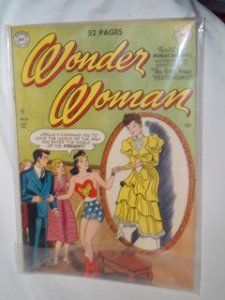
When I was a little Brooklyn brat, I was obsessed with having Wonder Woman underoos, you know because of the whole Linda Carter being on TV Wonder Woman age. Instead I got batgirl underoos – so I thought I’d try again and I chose this time to be obsessed with a Wonder Woman bathing suit. When we took our big family trip to Atlantic city in the heart of the Winter (to this day I can’t explain why we were there) and my grandparents came along – by grandparents I am referring to my grandmother Sara and her second husband “Uncle Charles.” Uncle Charles was really my step grandfather and he was like a big teddy bear like winnie-the-pooh. Well, I got sick in atlantic city and was stuck in the hotel, and Uncle charles had remembered me oggling over that bathing suit in the window during the summer and came to my room with my first Wonder Woman comic book – a compilation of a few Wonder Woman comics.
After that, Wonder Woman wasn’t just about Linda Carter being pretty and saving people. It was about a woman who came from a different place – something I always felt about myself- and came into the modern world for love of a man and his cause … fighting the enemies – the enemies being the Nazis (and growing up Orthodox Jewish – BOY was that story at the forefront of my life.)
*sidenote – I am not orthodox now, nor was I really ever, my reason being “it didn’t stick” … anyway, back to WW – she could run 60 mph on 4 inch heels, she had a great figure and best of all she had long black curly hair “like someone else I know.”

OK, so being Orthodox and having nothing to do about every Friday night for my entire childhood but sit by the light of the closet that we were allowed to leave on and read truly tasteless jokebooks and archie comics, I started to read my Wonder Woman comic book over and over and over until the binding ripped, and then duck taped the binding back together and read it over and over and over – you get the point (by the way, silly putty did not pick up the print of this book, only my archie comics did.) I think over time, studying every color – every word … every moment of these pages where Wonder Woman is educating those less enlightened how to treat each other and how to take care of oneself and empowered others to take control of their destiny and basically cleaned up other people’s messes, part of my soul consistently related to Wonder Woman and part of me actually became a “Wonder Woman” as you shall see.

I would twirl around in elevators in between floors pretending to turn into her and step off the elevator on my tippy toes pretending I was in her Wonder Woman uniform with 4 inch heels – remember – flat foot Diana Prince – tippy toes Wonder Woman. I would role play Wonder Woman with my friends and tie them with the magic lasso that makes them tell the truth (side note – the author of Wonder Woman was also the inventor of the lie detector – cute,huh).
Fact – my father is a JAG in the Army reserves … .Wonder Woman was in love with Steve Trevor – a Colonel in the US Army during WWII who crashed on her all woman greek island (located in the Bermuda triangle) and Wonder Woman tricked her queen mother to allow her to be the one to bring him back to Washington DC. A bit electra, don’t you think? I am proud of my father who, to this day, volunteers his time to the USA to help give law advice to active servicemen who were reservists and want to know their rights as sudden active duty men. Is that enough proud American for you yet? Hehe
Wonder Woman represents America. Her uniform in itself is American – the top being the American eagle, her shorts the stars of our flag and her colors red white and blue.

So I, Vivian, the Jewish tomboy from Brooklyn, finished private Hebrew school, graduated Brooklyn College with a Bachelors in Athletic Training (I was a bodybuilder during those college years – a typical date would have an arm wrestle in it somewhere) and got a Masters In Physical Therapy. I also came down with Epstein Barr Virus (EBV), otherwise known as chronic fatigue syndrome, in my sophomore year of college, but damned in hell if I wasn’t going to do what I needed to do to free myself from my Orthodox community and their multitude of rules. Back then it was referred to as “the yuppie disease” because people didn’t understand what it was. Even my own parents thought “oh, Vivi – you’re just working too hard” but it really was a mono type illness that just stays with you forever until you clean it into remission in some way.
So even though I was sooooo tired, my joints ached, and the constant pain I lived with excruciating – I studied for my tests and lost my ability to body build and got through school to get a job that can have me earn enough money to not rely on my family and live how I want to live. You see, when you have EBV you’re given a certain amount of energy at the beginning of the day and you decide how you want to use it – either mentally (studying), physically (staying up) or emotionally (dating). I had to chose daily which one was the priority … mind you with my Wonder Woman will I managed to party through school, teach myself how to ride a motorcycle, date the prince of Morocco, and have timeshares in the Hamptons.

I think that’s a cool American story so far, don’t you? But there’s more.
I worked in New York once I got out of school and was an orthopedic therapist in NYC for 3 years. I lived in the Village and roller-bladed through the World Trade Center buildings every day to get to work down at the bottom of Broadway. My dad’s office was across the street and we met for lunch. That was the thrill of my day. I love my dad and am so proud of who he has been for this country. He went back to work 3 days after the trade center fell to say F-U to the terrorists. He’s so cool. Proud like Wonder Woman.
I moved out to LA in 2000 and I got a job working in the Cedar-Sinai outpatient orthopedic center. I worked there for 3 years while studying for an even further specialization in orthopedic and sports medicine. Then I was transferred to the spine center and created relationships with the doctors there, ones that I have to this date. As a matter of fact, Cedars-Sinai spine center is my primary referral to my clinic to help their patients.
After working at Cedars for over 3 years I realized if I wanted to climb the corporate ladder I would have to kill about 30 people that were ahead of me in line or go off on my own. I left Cedars and became director of a Pilates based physical therapy clinic in Brentwood, which later opened a satellite clinic in Beverly Hills. During that time I took a 6 month course to understand how to integrate Pilates into my bag of tricks which I now integrate into my sessions in my own clinic called “Prevent The Pain Therapy, Inc.”- because we don’t just get you better, we point out the patterns that your body has done to keep you in pain and re-pattern you so you never become a patient again – just refer everyone you’ve ever known to come to us.
After being Chief Therapist in a Pilates based PT clinic in Brentwood, I started my OWN clinic called Vivie Therapy (www.VivieTherapy.com), which has been growing steadily for the past 14 years. I have a healing facility that integrates some of the latest greatest healing techniques and integrate eastern and western medicine to take the best out of both and help people as quickly as possible get out of their pain to return them to full function.
Lets sum this up.
I have molded my life into being a Wonder Woman. I help people and heal them where others have failed. I have been told I am a Wonder Woman by people who were unaware of my fetish. I help people who have been to dozens of other practitioners without relief. I am a stand for global awareness regarding educating people how to PREVENT THE PAIN because our medical field is a piece of … well, you know. Drugs, surgeries, but no solution. I am on a mission of healing the planet and making tremendous shifts of self body awareness and maintenance for a planet that is in a poor state. And no Halloween goes on without me in my Wonder Woman outfit for at least 5 parties.
I wonder whether my WW collection helped me become something greater then I was, or whether I was always living into a preordained destiny of becoming a Wonder Woman for my generation.
I have the largest Wonder Woman collection that I or anybody I know knows of – including a custom Wonder Woman outfit.
When I moved out to Los Angeles in 2000 and got a custom-made Wonder Woman outfit, I had a costume birthday party in February because the costume wasn’t done in time for Halloween. One of the gifts that I received on my birthday was a compilation of items that had Wonder Woman and a lightbulb went off. My mother collected salt-and-pepper shakers and depression glass, why not collect Wonder Woman memorabilia? This was also at the time that eBay started. So it wasn’t just about collecting Wonder Woman memorabilia, it was also about winning on eBay. This was before any of those websites that they did for you existed so it became a sport to this athlete. Before you know it we have the collection that I have today. Most of what I own was bought between 2003 and 2006 and now I just go on to eBay periodically and see what they have.
Now that the movie is out, my savings are in jeopardy with all the new items for my collection.
Vivian Eisenstadt
Why You Shouldn’t Wait Until The New Year To Get In Shape
Ah, the new year; it’s a chance to start over, a new beginning, a fresh start.
Well, maybe in the theoretical sense. But really, the first of January is just like any other day of the year. So, contrary to the whole idea of setting “New Year’s Resolutions,” when it comes to setting and working towards new goals, it doesn’t really make any sense to wait for a turn in the calendar to get started.
In fact, this holds true especially when it comes to your health and fitness.
“Your health and your body and the care you put into it should be valued highly,” says Stephanie Lauren, a certified personal trainer, nutritional health and wellness coach and the founder of Plyoga Fitness.
She points out that your health and fitness shouldn’t be determined by the season or time of year. Rather, you should place a focus on taking care of yourself year round.
“You get one body to live in your whole life,” she adss.
Bottom line: why put something as important as your health and wellness on the backburner when you can start making improvements right now?
Obviously that’s a rhetorical question, but a few experts that I talked to did share some great reasons that explain why you absolutely shouldn’t wait.
Vivian Eisenstadt MAPT, CPT, MSP, CEO is a personal trainer and Chief Physical Therapist at Vivie Therapy in Los Angeles; Mike Dewaris a certified national strength and conditioning coach, personal trainer and the Co-Founder of J2FIT Human Performance; Stephanie Dreyer is the founder of VeegMama, a lifestyle blog sharing new approaches to healthy living through food, wellness and personal fulfillment; and Maurice Buchanan is a personal trainer and the owner of UGO1 Fitness.
Continue reading to find out their expert advice.

You’ll approach the holidays with a different attitude.
Eisenstadt says that if you continue to focus on health and fitness starting now and through the holiday season, you may be less likely to overeat and overindulge. She suggests setting goals that will help to keep you motivated right now so that your mindset will shift from worrying about whether you’re eating too much to keeping track of the good things, like exercising and eating healthily, that you are doing.

You’ll have less work to do later.
“One of the main reasons people start their New Year’s ‘resolution’ to lose weight is because they overindulge during the holidays,” says Eisenstadt. “If you start now, you won’t have more weight to take off after the holidays, but instead you’ll be in a great place to continue a great habit you started in November.”
By Katie Rosenbrock
Sleeping Positions To Stay Healthy: The Best And Worst Ways To Sleep During The Night
 Decode your current sleep position and decide what is the best and worst for your health to get a good night’s rest. Photo courtesy of Shutterstock
Decode your current sleep position and decide what is the best and worst for your health to get a good night’s rest. Photo courtesy of Shutterstock
Getting a good night’s sleep is pivotal for our health, body, mind, and our mood, especially since we spend one-third of our lives asleep. While it is recommended every adult get seven to eight hours of sleep per night, according to the National Sleep Foundation, for many of us this is easier said than done. Sleep difficulty can be caused by a number of things, ranging from eating or drinking the wrong things before bed to our sleep position.
“Eighty percent of the population will have back problems at some point in [their] lives oftentimes caused or aggravated by the way they sleep,” Dr. Hooman Melamed, an orthopedic spine surgeon at the DISC Sports & Spine Center in Los Angeles, Calif., featured on The Doctors,Dr. Oz, and The Steve Harvey Show, told Medical Daily in an email. This suggests our p.m. pose could be the cause of our back and neck pain, stomach troubles, and even premature aging. To discover the best sleep positions for our body and the ones we may want to avoid, Medical Dailyhas put together a list so you can optimize your hours of sleep and stay healthy.
Best Position: On Your Back
Sleeping on our back makes it easier for our head, neck, and spine to align and keep it in a neutral position. No extra pressure or curves are being added to the back. “You are in the best position as your spine stays in natural alignment all night long,” Melamed said.
Dr. Michael Breus, known as “The Sleep Doctor,” is a clinical psychologist and both a diplomat of the American Board of Sleep Medicine and a fellow of the American Academy of Sleep Medicine, who also sides with Melamed’s recommendation of lying on your back during sleep. In Dr. Mehmet Oz’s sleep clinic last Thursday, Oz and sleep specialists answered questions and provided sleep tips for Twitter users using #DrOzSleepClinic, and via phone toll-free at 844-223-006. I asked the most common question most people have in mind: What#sleep position is best for our body in order to get a good night’s sleep?”
Starfish
This position is good for your back, too. It prevents facial wrinkles and skin breakouts. “Sleeping on your back also combats acid reflux,” said Dr. Decontee Jimmeh, a neurologist in Norwood Clinic in Birmingham, Ala. to Medical Daily in an email. Lying on your back means the head is elevated, and the stomach is able to sit below the esophagus, making it less likely for digested substances to come back up. It’s important to note sleeping in this position can result in snoring. In addition, placing your arms up adds pressure on the nerves of the shoulders, which leads to pain.
Second Best: On Your Side
Sleeping on your side is beneficial for patients who have obstructive sleep apnea, prone to general snoring, neck and back pain, and for those pregnant. Fletcher said “[S]leeping on one’s side is helpful by mechanically opening up a crowded oropharynx. It also elongates the spine, which helps back pain.”
Being a side-sleeper, however, can also cause unwanted skin aging, since placing one side of your face on the pillow can cause you to get wrinkles, and even leads to saggy breasts.
On The Right Side And On The Left Side
The side in which you sleep on can also play a role in your health. Sleeping on the ride side can worsen heartburn. However, sleeping on the left side can put a strain on internal organs like the liver, lungs, and stomach, but also while reducing acid reflux. Pregnant women are advised to sleep on their left side for optimal blood flow.
Vivian Eisenstadt, physical therapist in Los Angeles, Calif., told Medical Daily in an email, “if you’re going to sleep on your side, pillow prop using the following: an ergonomic pillow thick enough so your head doesn’t tilt down, a small pillow under your waist so your stomach doesn’t curve down, and a 3rd pillow between your legs.”
The Worst: On Your Stomach
Sleeping on your stomach is never advised because it doesn’t support the natural curve of your spine, leading to overarching. This places pressure on joints and muscles that can lead to pain, numbness, and tingling. “[I]t forces your neck to be in a rotated, closed pack, tight position, which also compromises your breathing and circulation,” Eisenstadt said.
Stomach-sleeping could be beneficial for those who snore as it helps keep the upper airways more open. However, this having the head to one side for a long period of time could soon lead to aching. This position should also be avoided for those who suffer from neck or back pain.
Second Worst: On Your Side With Knees Drawn Up To Chest (Fetal)
The fetal position may be comforting at the moment, but this can lead to neck and back pain, wrinkles, and saggy breasts. Sleeping in the fetal position can cause a strain on your back and joints, especially when your knees and chin are tucked into your chest. Melamed suggests we avoid sleeping on our side, like the fetal position, because the shoulder and neck should be aligned when sleeping. “You should choose a softer mattress to avoid press points but not one so soft that it doesn’t properly support your neck,” he said.
Sleep positions and the type of mattress you have play a major role in providing support along the contours of your body as you lie in bed. Placing pressure to any given parts of the body can disrupt sleep. A good night’s sleep requires a good sleeping environment, a good mattress, and plenty of rest.

Read this article at MedicalDaily.com
NailPro Magazine Feature – Tunnel Vision
Tunnel Vision
For those who work with their hands, carpal tunnel syndrome can be downright debilitating. Here, expert advice and treatment options to ease the pain.
According to the American College of Rheumatology, carpal tunnel syndrome (CTS) is relatively common, affecting 4 to 10 millions Americans. The good news? It’s usually treatable. In this month’s Nail Clinic, we’ll delve into the causes and symptoms of this condition as well as ways to combat the pain it causes.
WHAT IS CTS? According to Kevin Cronin, president and owner of ARC Physical Therapy in Chicago, CTS is a medical condition that occurs when the median nerve, which runs from the forearm to the palm of the hand, becomes pressed or squeezed at the wrist. The median nerve controls sensations to the palm side of the thumb and fingers (excluding the pinkie finger), as well as impulses to some small muscles in the hand that allow the fingers and thumb to move. “The carpal tunnel-a narrow, rigid passageway of ligament and bones at the base of the hand-houses the median nerve and tendons,” says Cronin. “In the case of CTS, thickening from irritated tendons or other swelling narrows the tunnel and causes the median nerve to be compressed.”
This compression can cause symptoms that include tingling and numbness and/or pain in one or more fingers, or in the entire hand, says Vivian Eisenstadt, CEO and physical therapist at Vivie Therapy in Los Angeles, who notes that repetitive activities, like those done by a nail tech, can aggravate symptoms. “CTS can occur when individuals use their hands too much for too long, such as by working on nails, because you hold your fingers and hands in certain positions for hours on end, “she says. CTS isn’t always work related, though, says Barbara Bergin, an orthopedic surgeon in Austin, Texas. “Many of us are predisposed to carpal tunnel syndrome, either genetically or because we live a long time and do a lot of movements, both heavy and repetitive, with our hands, ” she says, adding that the majority of her CTS patients do not perform particularly heavy or repetitive work, but rather routine and low-level amounts of lifting, manipulating and typing.
COPING WITH CTS
If you are experiencing pain, tingling or numbness, the first step to recover is to see a physical therapist or doctor. The symptoms of CTS can mimic other conditions, such as repetitive strain injury, so proper diagnosis can rule out any additional problems. While surgery is available to help extreme cases of CTS, for less severe symptoms, Eisenstadt recommends physical therapy, which relaxes and stretches the carpal tunnel area. The following tips can also counteract tingling and numbness in the hands:
- Take regular breaks throughout the day, making sure to stretch your forearms, hands and wrists. Cronin recommends a wrist flexor stretch every two or three hours, holding the position for six seconds on each wrist.
- Stretch your neck and your shoulders. Many times, numbness and tingling in the hand originates from the shoulder or neck as a result of sitting in a poor position for too long.
- Place an ice cube where your fourth finger meets the palm, flex and rub the area with the ice for 5 to 10 minutes. This increases blood flow and releases pressure on the palm.
- Have a massage therapist perform deep-tissue strokes on your forearms and hands.
- Put your hands in warm water for five minutes, then very cold water for five minutes, switching back and forth for 20 to 30 minutes. This improves circulation in your hands.
Bergen also recommends wearing gloves, which will help loosen your grip on implements and other items. additionally, wearing a wrist brace, during the day or at night, will prevent hyperflexion, or flexing the wrist beyond its normal limits, “Sometimes, simply doing these small things will keep you from having symptoms during your workday,” he says. If do-it-yourself tactics don’t alleviate your symptoms, additional treatments may help. Cronin recommends fascia strain and counterstrain, a gentle procedure that focuses on relieving tightness in the fascia, or connective tissue. “Tightness in the fascia and/or the muscles can spasm higher up in the arm, and even to the neck, causing tension in the nerves of the forearm and wrist, which contributes to CTS,” he explains.
During fascial strain and counterstrain, the medical professional identifies tender points in the hand, arm or neck which are associated with tight facial structure. Then, using her hands, the practitioner will manually shorten the tight fascia and hold that position for 30 seconds. This action eliminates the tender points and tightness thus releasing tension in the tissue. ” When the adverse tension on the nerve is removed, the irritation of the nerve lessens, and so do the symptoms,” says Cronin, who notes that most patients begin to feel relief almost immediately. Proper treatment for CTS, in addition to taking the necessary steps to reduce your discomfort throughout the day, will help you continue to be a successful and productive nail tech for years to come.
Carpal Tunnel Facts*
- Carpal tunnel syndrome (CTS) is the most expensive of all work-related injuries. Over a lifetime, a carpal tunnel patient loses about $30,000 in medical bills and time absent from work.
- Studies have shown that vitamin B 6 supplements may relieve CTS symptoms.
- CTS typically occurs in adults, and women are three times more likely to develop it than men.
- CTS usually affects the dominant hand first, and the pain is typically severe.
*Source: American Chiropractic Association (acatoday.org)

Vivie Therapy on Career Sighted
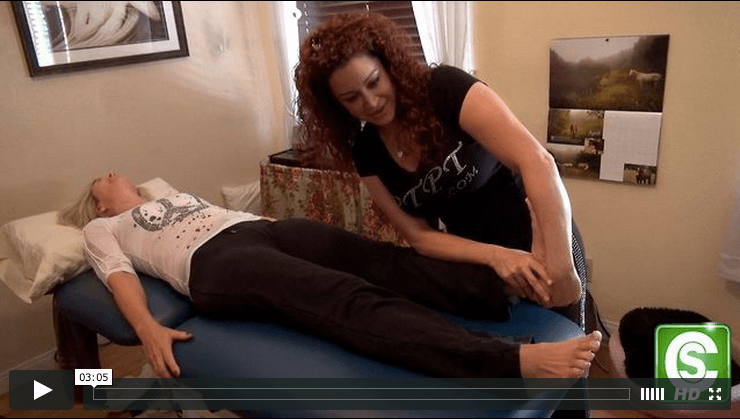
Meet Vivian, your Career Guide in this video! She’ll show you what it’s like to be a Physical Therapist. If you love exercise and helping people eliminate stress and pain, this could be the career for you!
Physical Therapy—Not Just for Rehab, Now Great for Prehab
Now that laws have been passed allowing direct access to physical therapists without a doctor’s prescription, skip the long doctor appointments, the drugs, epidurals and surgeries with no relief and get your mind set on PREHABilitation. It’sa proactive way to train the most often injured areas of your body.Expand your mind on physical therapy techniques that can benefit you before you hurt. Whatever you do for a living, your body is your instrument. Let a physical therapist align your body into balance, teaching you how to move your body in a way that’s like a workout, reinforcing good habits and preserving your body from future injury. When your neck and lower back first start to ache, a physical therapist can get you out of pain and make sure you only come back once a month to tune-up your instrument. Physical therapists will put the bones back into place and give you exercises and stretches so those bones stay where they’re put. A physical therapist will also look at how you hold and handle your stress.

[Editors note:When you think about physical therapy, what comes to mind is an injury or a car accident that already happened, after which physical therapy was prescribed by your doctor. Well, these days that’s so pass, as friend of Frontiers VivianEisenstadt explains in the piece below.]
Now that laws have been passed allowing direct access to physical therapists without a doctor’s prescription, skip the long doctor appointments, the drugs, epidurals and surgeries with no relief and get your mind set on PREHABilitation. It’sa proactive way to train the most often injured areas of your body.Expand your mind on physical therapy techniques that can benefit you before you hurt.
Whatever you do for a living, your body is your instrument. Let a physical therapist align your body into balance, teaching you how to move your body in a way that’s like a workout, reinforcing good habits and preserving your body from future injury. When your neck and lower back first start to ache, a physical therapist can get you out of pain and make sure you only come back once a month to tune-up your instrument. Physical therapists will put the bones back into place and give you exercises and stretches so those bones stay where they’re put. A physical therapist will also look at how you hold and handle your stress.
Want to not get hurt at the gym? Let a physical therapist teach you how to mindfully turn on your abs and shut them offwith every exercise. Get help finding the muscles your trainer is yelling at you to use when you have no idea where the hell they are.
Want to improve your body mechanics and shave seconds off your mile? Let a physical therapist analyze your run to maximize efficient movement.
To combat neck pain, back pain or slumping in your chair, physical therapists use targeted massage therapy, pilates, stretching and strengthening as well as alternative modalities like whole body vibration therapy, infrared light therapy and standard ultrasound to have you operating at your peak.

Do Your Muscles Hurt More When It’s Cold Outside?

Cold weather causes muscles to lose more heat and contract, causing tightness throughout the body. Joints get tighter, muscles can lose their range of motion and nerves can more easily be pinched, according to Los Angeles-based orthopedic physical therapist Vivian Eisenstadt.
Thanks to the effects of colder temps, muscles are forced to work much harder to complete the same tasks they complete easily in milder weather. This causes more damage to the muscle tissue and can result in increased soreness. To counteract the damage, be sure to warm up for a little longer than usual.
“It is normal to feel muscle soreness for a few days after exercise, especially if it is a different type of activity or at a more intense level than your body is used to,” says Amy McDowell, a physical therapist and Pilates instructor from ARC Physical Therapy in Chicago.
“If you feel more sore in the winter after the same level of exercise than you do the rest of the year, it could be that your body needs a longer warm-up period.”
Try beginning your workout with light cardio exercises, like brisk walking. This will raise your core temperature and ensure that oxygen and blood are flowing throughout your body.
A basic rule of thumb is that you should warm up for 10 minutes when the temperature is between 35 and 45 degrees Fahrenheit. For each 10-degree temperature drop below 35, extend your warm-up by five minutes.
Brandon Mentore, a health coach based in Philadelphia, recommends a combination of exercises and stretches for an effective warm-up.
Some bodyweight exercises — like push-ups, dips, squats, lunges and bicycle crunches — are ideal for getting your blood flowing after your warm-up walk, Mentore says. Then, after those exercises, stretch only the tightest muscle groups in your body; for most people, these groups include the hamstrings, quadriceps, chest and shoulders.
Follow your warm-up with a cool-down that takes about the same amount of time. However, in addition to stretching the body’s tightest muscle groups, also focus on other areas like the back, arms and calves. “This will prevent muscle soreness and enhance your overall performance during the winter,” Mentore says.
Instead of giving up on winter exercise, modify the way you work out to feel and look your best throughout the winter months. Bonus? The healthy habits you pick up can be incorporated into your warm-weather workouts.
